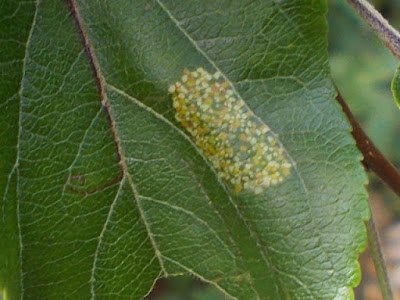I was very pleased, when walking, in our neighbourhood today, to find evidence that the recent wildlife campaigns, basically calling upon people to 'forget the lawnmower' are having an effect. Here and there Chris and I have chanced upon gardens where the owners have done just that, with remarkable results.
 |
| Yeomanry Close, Daventry. 19 July, 2020 |
It may be that the bulk of organisms that take advantage of the new habitat are commonplace, but all have a place in the resultant food webs. Imagine the delight a child - or indeed, an adult - will get from seeing cinnabar caterpillars on groundsel and ragworts.
 |
Caterpillars of the Cinnabar, Tyria jacobaeae. Yeomanry Way, Daventry.
19 July, 2020
|
And of course, if they see the imago, that is a bonus.
 |
| The Cinnabar imago is a lovely creature. |
Given time many other organisms will move in and one of the creatures which could benefit is the hedgehog. I was reminded of this when, a little later, I ended up in our local pocket park. I was told recently that hedgehogs, or to use the older vernacular term of urchins, are frequent in Stefen Hill Pocket Park at dusk. But I am rarely out that late so to find a specimen in the daytime, as I did today, was a pleasant surprise.
 |
Hedgehog, Erinaceus europaeus, in Stefen Hill Pocket Park.
19 July,2020
|
It was quite a young specimen and was out on the grass in a potentially vulnerable situation where dogs (of which there are many) could bother it, so I moved it into a rather concealed area of long grass.
Each year, around now, the female catkins on the alder trees show that they have been infected by alder tongue, Taphrina alni. Of course the tongue-like growth has been developing for many weeks but it is now that they become conspicuous. Given a few more weeks they could turn red or even purple. These female catkins are often referred to as cones, and indeed in winter they do look cone-like but structurally they are quite different.
 |
The tongues of the fungus, Taphrina alni, are now obvious on female
alder catkins.
|
There are several apple trees dotted around the pocket park and the fruit, though not to the taste of most people, can become an important autumn/winter food for thrushes and other creatures.
 |
Apple trees are carrying a heavy crop of fruit.
Stefen Hill Pocket Park, 19 July, 2020
|
I examined the fruit of one tree but in truth the foliage was more interesting. It had been mined by the larvae of (probably) Callisto denticulella.
Known as the Garden Apple Slender, this moth is frequent in orchards and gardens over much of Europe.
 |
| The Garden Apple Slender |
Maybe sometimes I'll be able to find the rather attractive imago.

No comments:
Post a Comment